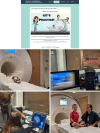Achieving Clinical Success in Nonsedated Velopharyngeal Magnetic Resonance Imaging: Optimizing Data Quality and Patient Selection
- PMID: 38991113
- PMCID: PMC11845073
- DOI: 10.1097/PRS.0000000000011619
Achieving Clinical Success in Nonsedated Velopharyngeal Magnetic Resonance Imaging: Optimizing Data Quality and Patient Selection
Abstract
Background: The ability of magnetic resonance imaging (MRI) to visualize the velopharyngeal (VP) musculature in vivo makes it the only imaging modality available for this purpose. This underscores a need for exploration into clinical translation of this imaging modality for craniofacial teams. The purpose of this study was to assess outcomes of a clinically feasible VP MRI protocol and describe the ideal patient population for use of this imaging protocol.
Methods: Sixty children (2 to 12 years of age) with VP insufficiency underwent a nonsedated, child-friendly MRI protocol. No exclusions based on syndromic conditions were made. Logistic regression assessed predictors of VP MRI success and multinomial logistic regression evaluated factors influencing quality of anatomic data.
Results: An 85% overall success rate was achieved, including children as young as 2 years and those with syndromic diagnoses. Stratifying by age revealed a 97.5% success rate in children ages 4 and up. The regression model (χ 2 [5] = 37.443; P < 0.001) explained 81.4% of success rate variance, correctly classifying 93.3% of cases. Increased age significantly predicted success ( P = 0.046); sex and syndromic conditions did not. Multinomial regression identified preparatory materials ( P = 0.011) and audio/video during the scan ( P = 0.024) as predictors for improved image quality.
Conclusions: Implementation of VP MRI is feasible for a broad population of children with VP insufficiency, including those with concomitant syndromic diagnoses. Quality is improved by incorporating prescan preparation and audiovisual stimuli during scans. This underscores the potential of VP MRI as a valuable tool in clinical settings, especially for presurgical assessments.
Copyright © 2024 The Authors. Published by Wolters Kluwer Health, Inc. on behalf of the American Society of Plastic Surgeons.
Conflict of interest statement
The authors have no conflicts of interest to disclose with respect to the research, authorship, and/or publication of this article.
Figures




References
-
- Mason K, Perry J. The use of magnetic resonance imaging (MRI) for the study of the velopharynx. Perspectives ASHA Special Interest Groups 2017;2:35–52.
-
- Drissi C, Mitrofanoff M, Talandier C, Falip C, Le Couls V, Adamsbaum C. Feasibility of dynamic MRI for evaluating velopharyngeal insufficiency in children. Eur Radiol. 2011;21:1462–1469. - PubMed
-
- Maturo S, Silver A, Nimkin K, et al. . MRI with synchronized audio to evaluate velopharyngeal insufficiency. Cleft Palate Craniofac J. 2012;49:761–763. - PubMed
-
- El Banoby T, Hamza F, Elshamy M, Abdelmonem A. Role of static MRI in assessment of velopharyngeal insufficiency. Pan Arab J Rhonol. 2020;10:21–26.
MeSH terms
Grants and funding
LinkOut - more resources
Full Text Sources
Medical

